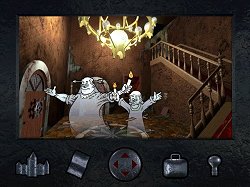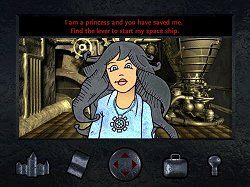|
The Mystery at Greveholm
 Released for the PC and Macintosh in 1997 The Mystery at Greveholm is a first person perspective children's game all about rescuing a princess in a haunted castle. She landed there in her spaceship and was taken prisoner, and is now guarded by a skeleton. Released for the PC and Macintosh in 1997 The Mystery at Greveholm is a first person perspective children's game all about rescuing a princess in a haunted castle. She landed there in her spaceship and was taken prisoner, and is now guarded by a skeleton. Maybe a little creepy, but the 'fright' factor is fairly low. The skeleton does pop up a few times, but it doesn't really threaten, and disappears quite quickly except on one occasion when it steadfastly refuses to move from in front of a door. It's so innocuous only the most nervous young player will be worried.
There are two ghosts, too, floating through Greveholm Castle Hall when you arrive. They look happy and friendly despite having weapons piercing their bodies, and are gone in a few seconds. Then it's up to the player to start searching around, fix a few things, find a few clues, put Spark (the robot) together again, solve some puzzles, play some games, and proceed with the rescuing. It's a simple little game aimed a ages 9+. The graphics are pretty reasonable for their age, but a bit pixellated by today's standards, especially played in 640 x 480 resolution which fills the screen. The playing area is framed in a window with 6 large icons across the bottom, two of which are hardly used in the game, hardly worth having. One is used a couple of times to view some clues and the other, as I recall, only once to get the robot to help. The remaining three icons are for inventory access, exiting to the opening screen for saving and loading and, finally, a compass rose.
Just click on an arrow for movement or the keyboard arrow keys work just as well. Objects that can be collected highlight brilliantly so they can't be missed, just click when the cursor turns into a cog. This is the only variation in the appearance of the cursor because it's not used for navigation and it doesn't indicate hotspots where something must be done unless there is a zoom function to get a closer look. For instance, the cursor reacts when you find a key but not the for keyhole where you use it. For the keyhole to respond it needs the key in hand to activate it. It would have been better had the cursor always responded to all hotspots, but this omission isn't too much of a problem as it's usually obvious what to do with an object, and where.
 In fact the idea in this game is to look around, click when the cursor changes and see what happens. If it's not something to pick up or zoom in on, then it's often a little game to play and winning it will make something happen. This is indicated by a sound, so there might now be a door magically opened or, maybe, an item has appeared in the gameworld. So it's off to search for that mysterious happening. Sometimes it's nearby, sometimes it's far away (comparatively speaking). In all there are three or four little games including a memory exercise, one involving digital and analogue time, plus a game of Pong and a simple shooting exercise. In fact the idea in this game is to look around, click when the cursor changes and see what happens. If it's not something to pick up or zoom in on, then it's often a little game to play and winning it will make something happen. This is indicated by a sound, so there might now be a door magically opened or, maybe, an item has appeared in the gameworld. So it's off to search for that mysterious happening. Sometimes it's nearby, sometimes it's far away (comparatively speaking). In all there are three or four little games including a memory exercise, one involving digital and analogue time, plus a game of Pong and a simple shooting exercise. Mystery at Greveholm isn't a long adventure and the gameworld is fairly small which is just as well because there is some walking back and forth to do to discover what's changed when the triggers are tripped. This searching for what might have happened is part of the game plan and it adds a layer of challenge.
Though it has its quirks, and it could have done with a bit more polish, there is some mild fun to be had for younger players in Greveholm Castle. With the mini games it is essentially part adventure and part activity oriented, so it's a pity that all the games couldn't be accessed individually apart from the actual adventuring so they could be played again and again. This would have extended playing time. Mystery at Greveholm ran perfectly fine in Win XP (Win 98 compatibility mode) with Director Player 5 installed and a reduction in virtual memory.
Copyright © Rosemary Young 2004.
All rights reserved.
System Requirements:
Win 3.1/95/98, Pent 75, 16 MB RAM, 4X CD ROM, 256 colour svga, 16 bit sound card, mouse.
Mac - 68040, System 7 or later, 16 MB RAM, 4X CD ROM, 256 colour, mouse.
|
